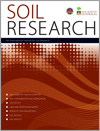Floodplain forests represent a unique ecosystem, the stability of which depends on periodic flooding; however, construction of flood embankments may completely cut off such habitats from seasonal floods. Enzyme activities are significantly lower in soil without seasonal flooding than in soil in seasonally flooded areas. Soil moisture, not season, is the main factor influencing the enzymatic activity of temperate floodplain forests.
SR21156 Abstract | SR21156 Full Text | SR21156PDF (1.3 MB) Open Access Article





